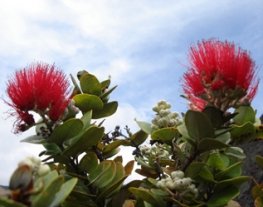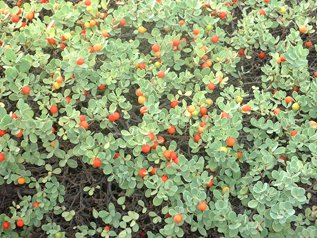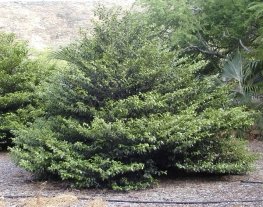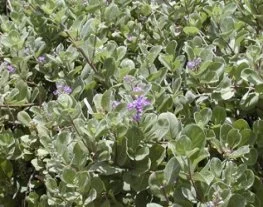Plant species
Ōhiʻa | Metrosideros polymorpha
Of the five different species of ‘ōhiʻa recognized, this is the most variable. The leaves of this plant range from 1/2″ to 3″, they can also be very glabrous or very hairy. The new leaves or liko range in color from dark purple, almost black to red, gold and everything in between. Some plants bush out while others grow to over 80 ft. tall. The ‘ōhiʻa or lehua as some people call it, are best known for their flowers. They are just as variable as the plants themselves. Color ranges from very dark red (lehua ‘apane) all the way through to yellow (lehua mamo) or even white (lehua kea) according to some legends.
Distribution: Endemic to Hawaiʻi Island, Maui, Oʻahu and Kauaʻi. Today, the ʻōhiʻa is an endemic plant found on all of the main islands except Niʻihau and Kahoʻolawe, but they were most likely there in the past. Today ʻōhiʻa are found mainly at higher elevations, although there are some places where you can still see them on the coast and in lowland dry forests but these instances are rare. Originally, their range extended from sea level all the way up to around 6,500 ft.
Landscape Use and Care: Plant ʻōhiʻa anywhere. It is such a beautiful plant it deserves to be as dominant in the landscapes as it is in the native forests. Once planted it should be watered daily for up to 3-4 months in well drained soil. After that once every 2-3 days is sufficient unless you live in a very dry place or on the beach. Generally the plant reaches a height of about 15-30 feet in the landscape but height can be controlled by pruning, this also stimulates bushiness. Stem borers sometimes eat out stems and eventually the whole plant, often killing it. If you see a limb beginning to dry out, cut it off immediately to prevent further damage.
Cultural Uses: One of the most important woods in Hawaiian culture, ʻōhiʻa was used for a number of things: in house construction, rafters and posts were made of it; decking, seats and gunwales of canoes were also made of ʻōhiʻa; various leis either used the flowers, flower buds or leaf buds of ʻōhiʻa; it decorated hula altars for the god Kukaʻōhiʻa and kiʻi, religious images, were made of ʻōhiʻa as well.
ʻĀkia | Wikstroemia uva-ursi
This endemic plant can easily be seen in numerous landscapes throughout the islands. This plant, along with naupaka, pohinahina, and pualoalo are among the most used native plants in Hawaiian landscapes today. Although in the wild it is quite rare, found only in dry, open, often disturbed, lowland or coastal habitats on Kauaʻi, Oʻahu Molokaʻi, and Maui where it is reported as far inland as ‘Īao Valley.
Cultural Uses: Many members of this genus Wikstroemia were used as a narcotic to catch fish. The bark, roots and leaves were pounded and mixed with bait and then thrown in the water to feed the fish; upon ingesting, the fish would swim in a “drunken” state which made them easier to scoop up with a net or to spear. The mashed plant parts are also used in Hawaiian spell casting and sorcery.
People often ask if the attractive fruit are poisonous and if they should worry about kids or pets eating them. It is believed to be the stem, leaves and roots that make the fish narcotic not so much the fruit and it only affects cold-blooded animals. Birds have been seen to eat the fruits with no ill effects and the fruit tastes so bad that any human who put it in their mouth would immediately spit it out.
Landscape Use and Care: This plant has proven itself over the years as one of the best landscape plants for Hawaiʻi’s environment, not just among native species but even non-native. They’re extremely hardy, requiring very little water and grow slow enough so that you don’t need to maintain them as much once they reach their desired height. Few pests, if any, bother ‘ākia and their bright colors when fruiting make this plant even more attractive. If you need a low hedge about 3 ft tall or a colorful accent plant that is easily shaped, then ‘ākia is for you.
Alaheʻe | Psydrax odoratum
This indigenous tree is found in the dry to mesic forests on all islands except Niʻihau and Kahoʻolawe. In certain places you can still find this plant along the coast.
Cultural Uses: Digging tools and adze handles were made from the hard wood of this plant while a black dye was made from the leaves. The flowers and fruit are also used in lei.
Landscape Uses and Care: Alaheʻe loves full sun and/or partial shade and requires minimal watering once the plant is established in the ground. Looks great as a single specimen plant or even used as a hedge.
Additional Info: The name alaheʻe means slippery/wandering fragrance. It gets this name because when in full bloom, the plant is completely covered in flower clusters and many times you’ll smell the plant before you actually see it.
Pohinahina | Vitex rotundifolia
Distribution: This is an indigenous plant, native to Hawaiʻi as well as other parts of the Pacific, even Japan. In Hawaiʻi it is found on sandy coasts of all the main islands except Kahoʻolawe, although it may have occurred there in the past.
Cultural Uses: The fragrant leaves of this plant can be layered between folded kapa to repel insects. The leaves and flowers can also be arranged in lei poʻo.
Landscape Uses and Care: An excellent plant for use in stabilizing soil. As it grows, the branches lean over and root at the nodes that are touching the ground. They make excellent ground covers for slopes that need help with erosion control. Generally, pōhinahina are quick growers and require very little water, they thrive in full sun. These plants respond well to pruning and can be formed into a low hedge; they also look great in pots for your lanai. To cover large areas, plant spacing of every two feet on center is close enough; they’ll fill in just fine. Few pests are known to bother this plant. It is hardy and easy to take care of. If you kill this plant then yes, your thumbs may be brown.
Additional Info: Besides pōhinahina, depending on which island you are on, this plant is also known as kolokolo kahakai, hinahina kolo, manawanawa, mawanawana, and polinalina.
Species information and photos adapted from Hui Kū Maoli Ola




